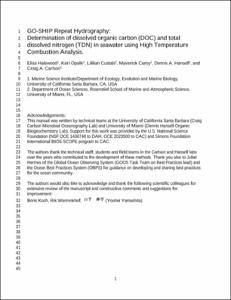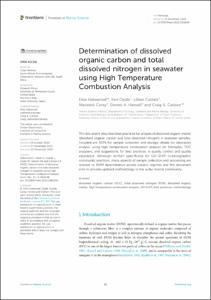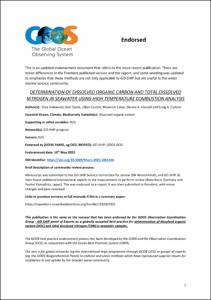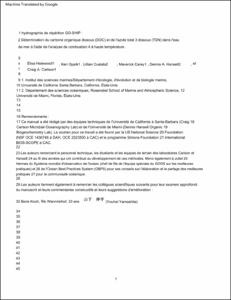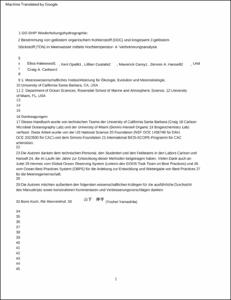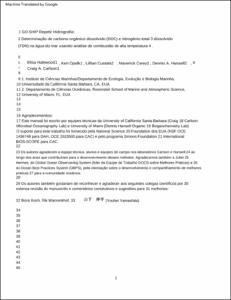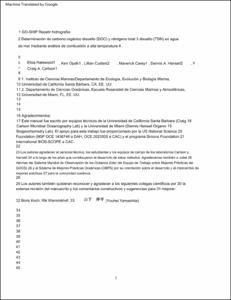| dc.contributor.author | Halewood, Elisa | |
| dc.contributor.author | Opalk, Keri | |
| dc.contributor.author | Custals, Lillian | |
| dc.contributor.author | Carey, Maverick | |
| dc.contributor.author | Hansell, Dennis | |
| dc.contributor.author | Carlson, Craig A. | |
| dc.date.accessioned | 2022-05-19T07:24:00Z | |
| dc.date.available | 2022-05-19T07:24:00Z | |
| dc.date.issued | 2022 | |
| dc.identifier.citation | Halewood, E., Opalk, K., Custals, L., Carey, M., Hansell, D.A. and Carlson, C.A. (2022) GO-SHIP Repeat Hydrography:
Determination of dissolved organic carbon (DOC) and total dissolved nitrogen (TDN) in seawater using High Temperature Combustion Analysis. Santa Barbara, CA , University of California, 32pp. DOI: http://dx.doi.org/10.25607/OBP-1745 | en_US |
| dc.identifier.uri | https://repository.oceanbestpractices.org/handle/11329/1921 | |
| dc.identifier.uri | http://dx.doi.org/10.25607/OBP-1745 | |
| dc.description.abstract | Dissolved organic matter (DOM), operationally defined as organic matter that passes through a submicron filter, is a complex mixture of organic molecules comprised of carbon, hydrogen and oxygen as well as nitrogen, phosphorous and sulfur. Resolving the dynamics of each DOM fraction helps to elucidate the greater questions of DOM biogeochemical cycling. At ~662 ±32 Pg (1015 g) C, oceanic dissolved organic carbon (DOC) is one of the largest bioreactive pools of carbon in the ocean (Williams and Druffel, 1987; Hansell and Carlson, 1998a; Hansell et al., 2009), and is comparable to the mass of inorganic C in the atmosphere (MacKenzie, 1981; Eppley et al., 1987; Fasham et al., 2001). Perturbations in the sources or sinks of the oceanic DOC pool impact the balance between oceanic and atmospheric CO2, perhaps making it climatically significant (Ridgwell and Arnt, 2014). In addition, most of the standing stock of fixed nitrogen in the surface ocean (<200m) is in the form of dissolved organic nitrogen (DON) (Bronk, 2002; Aluwihare and Meador, 2008; Letscher et al., 2013). As such, it is important to understand the processes that control DOC and DON distribution, inventories and fluxes in the global ocean. | en_US |
| dc.language.iso | en | en_US |
| dc.title | GO-SHIP Repeat Hydrography: Determination of dissolved organic carbon (DOC) and total dissolved nitrogen (TDN) in seawater using High Temperature Combustion Analysis.[GOOS ENDORSED PRACTICE] | en_US |
| dc.title.alternative | Determination of dissolved
organic carbon and total
dissolved nitrogen in seawater
using High Temperature
Combustion Analysis. | |
| dc.type | Journal Contribution | en_US |
| dc.description.notes | published version in Frontiers in Marine Science | en_US |
| dc.description.refereed | Refereed | en_US |
| dc.format.pagerange | 32pp. [Publisher version = 15pp.] | en_US |
| dc.subject.parameterDiscipline | Carbon, nitrogen and phosphorus | en_US |
| dc.subject.dmProcesses | Data acquisition | en_US |
| dc.subject.dmProcesses | Data analysis | en_US |
| dc.subject.dmProcesses | Data processing | en_US |
| dc.subject.dmProcesses | Data quality control | en_US |
| dc.description.abstractOtherLang | FRENCH === La matière organique dissoute (DOM), définie sur le plan opérationnel comme la matière organique qui passe à travers un filtre submicronique, est un mélange complexe de molécules organiques composées de carbone, d'hydrogène et d'oxygène ainsi que d'azote, de phosphore et de soufre. La résolution de la dynamique de chaque fraction de DOM aide à élucider les grandes questions du cycle biogéochimique des DOM. À ~662 ±32 Pg (1015 g) C, le carbone organique dissous océanique (COD) est l'un des plus grands réservoirs bioréactifs de carbone dans l'océan (Williams et Druffel, 1987; Hansell et Carlson, 1998a; Hansell et al., 2009 ), et est comparable à la masse de C inorganique dans l'atmosphère (MacKenzie, 1981 ; Eppley et al., 1987 ; Fasham et al., 2001). Les perturbations dans les sources ou les puits du pool océanique de COD ont un impact sur l'équilibre entre le CO2 océanique et atmosphérique, le rendant peut-être important sur le plan climatique (Ridgwell et Arnt, 2014). De plus, la majeure partie du stock permanent d'azote fixé à la surface de l'océan (<200 m) est sous forme d'azote organique dissous (DON) (Bronk, 2002 ; Aluwihare et Meador, 2008 ; Letscher et al., 2013). En tant que tel, il est important de comprendre les processus qui contrôlent la distribution, les inventaires et les flux de COD et de DON dans l'océan mondial. | |
| dc.description.abstractOtherLang | FRENCH === La matière organique dissoute (DOM), définie sur le plan opérationnel comme la matière organique qui passe à travers un filtre submicronique, est un mélange complexe de molécules organiques composées de carbone, d'hydrogène et d'oxygène ainsi que d'azote, de phosphore et de soufre. La résolution de la dynamique de chaque fraction de DOM aide à élucider les grandes questions du cycle biogéochimique des DOM. À ~662 ±32 Pg (1015 g) C, le carbone organique dissous océanique (COD) est l'un des plus grands réservoirs bioréactifs de carbone dans l'océan (Williams et Druffel, 1987; Hansell et Carlson, 1998a; Hansell et al., 2009 ), et est comparable à la masse de C inorganique dans l'atmosphère (MacKenzie, 1981 ; Eppley et al., 1987 ; Fasham et al., 2001). Les perturbations dans les sources ou les puits du pool océanique de COD ont un impact sur l'équilibre entre le CO2 océanique et atmosphérique, le rendant peut-être important sur le plan climatique (Ridgwell et Arnt, 2014). De plus, la majeure partie du stock permanent d'azote fixé à la surface de l'océan (<200 m) est sous forme d'azote organique dissous (DON) (Bronk, 2002 ; Aluwihare et Meador, 2008 ; Letscher et al., 2013). En tant que tel, il est important de comprendre les processus qui contrôlent la distribution, les inventaires et les flux de COD et de DON dans l'océan mondial. | |
| dc.description.abstractOtherLang | GERMAN === Gelöste organische Substanz (DOM), operativ definiert als organische Substanz, die einen Submikronfilter passiert, ist eine komplexe Mischung organischer Moleküle, bestehend aus Kohlenstoff, Wasserstoff und Sauerstoff sowie Stickstoff, Phosphor und Schwefel. Die Aufklärung der Dynamik jeder DOM-Fraktion hilft, die größeren Fragen des biogeochemischen DOM-Kreislaufs zu klären. Mit ~662 ±32 Pg (1015 g) C ist ozeanischer gelöster organischer Kohlenstoff (DOC) einer der größten bioreaktiven Kohlenstoffspeicher im Ozean (Williams und Druffel, 1987; Hansell und Carlson, 1998a; Hansell et al., 2009). ) und ist vergleichbar mit der Masse an anorganischem C in der Atmosphäre (MacKenzie, 1981; Eppley et al., 1987; Fasham et al., 2001). Störungen in den Quellen oder Senken des ozeanischen DOC-Pools wirken sich auf das Gleichgewicht zwischen ozeanischem und atmosphärischem CO2 aus und machen es möglicherweise klimatisch bedeutsam (Ridgwell und Arnt, 2014). Darüber hinaus liegt der größte Teil des Bestands an festem Stickstoff im Oberflächenozean (<200 m) in Form von gelöstem organischem Stickstoff (DON) vor (Bronk, 2002; Aluwihare und Meador, 2008; Letscher et al., 2013). Daher ist es wichtig, die Prozesse zu verstehen, die die Verteilung, Bestände und Flüsse von DOC und DON im globalen Ozean steuern | |
| dc.description.abstractOtherLang | PORTUGUESE === A matéria orgânica dissolvida (DOM), definida operacionalmente como matéria orgânica que passa por um filtro submicrométrico, é uma mistura complexa de moléculas orgânicas composta de carbono, hidrogênio e oxigênio, bem como nitrogênio, fósforo e enxofre. Resolver a dinâmica de cada fração DOM ajuda a elucidar as maiores questões do ciclo biogeoquímico DOM. A ~662 ±32 Pg (1015 g) C, o carbono orgânico dissolvido oceânico (DOC) é um dos maiores reservatórios biorreativos de carbono no oceano (Williams e Druffel, 1987; Hansell e Carlson, 1998a; Hansell et al., 2009 ), e é comparável à massa de C inorgânico na atmosfera (MacKenzie, 1981; Eppley et al., 1987; Fasham et al., 2001). Perturbações nas fontes ou sumidouros do reservatório DOC oceânico impactam o equilíbrio entre o CO2 oceânico e atmosférico, talvez tornando-o climaticamente significativo (Ridgwell e Arnt, 2014). Além disso, a maior parte do estoque permanente de nitrogênio fixo na superfície do oceano (<200m) está na forma de nitrogênio orgânico dissolvido (DON) (Bronk, 2002; Aluwihare e Meador, 2008; Letscher et al., 2013). Como tal, é importante compreender os processos que controlam a distribuição, inventários e fluxos de DOC e DON no oceano global | |
| dc.description.abstractOtherLang | SPANISH === La materia orgánica disuelta (DOM), definida operativamente como materia orgánica que pasa a través de un filtro submicrónico, es una mezcla compleja de moléculas orgánicas compuesta por carbono, hidrógeno y oxígeno, así como nitrógeno, fósforo y azufre. Resolver la dinámica de cada fracción de DOM ayuda a dilucidar las cuestiones más importantes del ciclo biogeoquímico de DOM. A ~662 ±32 Pg (1015 g) C, el carbono orgánico disuelto oceánico (DOC) es uno de los depósitos biorreactivos de carbono más grandes del océano (Williams y Druffel, 1987; Hansell y Carlson, 1998a; Hansell et al., 2009). ), y es comparable a la masa de C inorgánico en la atmósfera (MacKenzie, 1981; Eppley et al., 1987; Fasham et al., 2001). Las perturbaciones en las fuentes o sumideros de la reserva oceánica de DOC afectan el equilibrio entre el CO2 oceánico y atmosférico, lo que quizás lo haga significativo desde el punto de vista climático (Ridgwell y Arnt, 2014). Además, la mayor parte de la reserva permanente de nitrógeno fijo en la superficie del océano (<200 m) se encuentra en forma de nitrógeno orgánico disuelto (DON) (Bronk, 2002; Aluwihare y Meador, 2008; Letscher et al., 2013). Como tal, es importante comprender los proceso | |
| dc.description.abstractOtherLang | SPANISH === La materia orgánica disuelta (DOM), definida operativamente como materia orgánica que pasa a través de un filtro submicrónico, es una mezcla compleja de moléculas orgánicas compuesta por carbono, hidrógeno y oxígeno, así como nitrógeno, fósforo y azufre. Resolver la dinámica de cada fracción de DOM ayuda a dilucidar las cuestiones más importantes del ciclo biogeoquímico de DOM. A ~662 ±32 Pg (1015 g) C, el carbono orgánico disuelto oceánico (DOC) es uno de los depósitos biorreactivos de carbono más grandes del océano (Williams y Druffel, 1987; Hansell y Carlson, 1998a; Hansell et al., 2009). ), y es comparable a la masa de C inorgánico en la atmósfera (MacKenzie, 1981; Eppley et al., 1987; Fasham et al., 2001). Las perturbaciones en las fuentes o sumideros de la reserva oceánica de DOC afectan el equilibrio entre el CO2 oceánico y atmosférico, lo que quizás lo haga significativo desde el punto de vista climático (Ridgwell y Arnt, 2014). Además, la mayor parte de la reserva permanente de nitrógeno fijo en la superficie del océano (<200 m) se encuentra en forma de nitrógeno orgánico disuelto (DON) (Bronk, 2002; Aluwihare y Meador, 2008; Letscher et al., 2013). Como tal, es importante comprender los proceso | |
| dc.description.sdg | 14.a | en_US |
| dc.description.eov | Dissolved organic carbon | en_US |
| dc.description.maturitylevel | Mature | en_US |
| dc.description.adoption | Validated (tested by third parties) | en_US |
| dc.description.adoption | Multi-organisational | en_US |
| dc.description.adoption | International | en_US |
| dc.description.methodologyType | Method | en_US |
| dc.description.methodologyType | Specification of criteria | en_US |
| obps.endorsementAuthorDeclared.bestPractice | GO-SHIP | |
| obps.endorsementExternal.externalEndorsedBy | GOOS | |
 Repository of community practices in Ocean Research, Applications and Data/Information Management
Repository of community practices in Ocean Research, Applications and Data/Information Management
